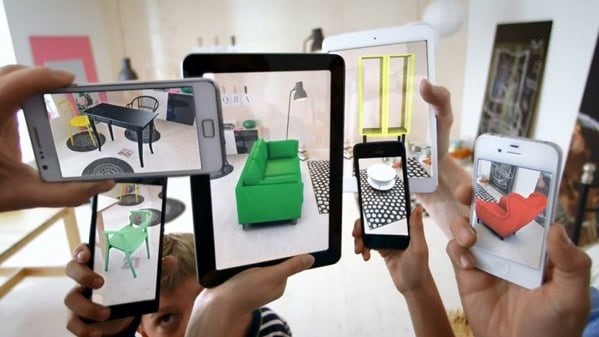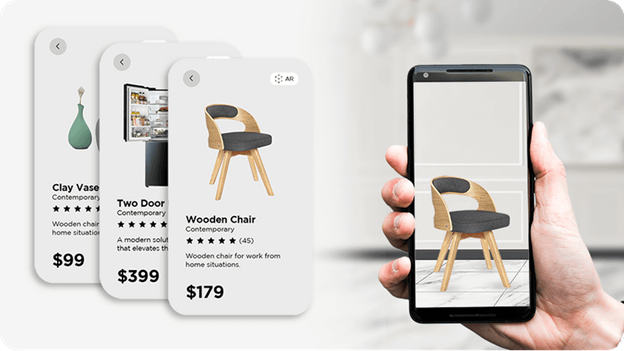XR Digital
At XR Digital, we blend creativity, technology, and strategy to deliver unparalleled digital solutions. Explore the possibilities with us as we push the boundaries of innovation and transform your vision into reality.

Online shopping has a major drawback: it cannot provide a full sensory product experience. Unlike in a physical store, where you can feel the fabrics, try on the clothes, or see how a couch fits in a room, online shopping limits your senses.
However, ecommerce can overcome this limitation with augmented reality (AR) applications. AR applications can show you more realistic and detailed information about the products, such as how they look on you or in your space, without leaving your home.
Augmented Reality (AR) has revolutionized the way we experience and interact with the digital world, and its integration into the realm of e-commerce has opened a new frontier of possibilities. In this digital era, the marriage of Augmented Reality and e-commerce has given consumers the ability to visualize products in their own physical space before making a purchase.
If you create a VR application, the number of people who have the equipment available to experience it are far fewer than the 3 billion smartphone users in the world today! So, AR seems also more accessible, it requires less equipment and fewer safety precautions.
This explores how Augmented Reality in e-commerce is transforming the online shopping landscape, providing consumers with immersive and personalized experiences that bridge the gap between the virtual and physical shopping realms.

Within the realm of Augmented Reality (AR), various technologies offer distinct capabilities, catering to diverse user experiences. Here’s a comprehensive overview of the common types of augmented reality applications:
Also known as Image Recognition or Recognition-based AR, this technology involves detecting a specific object, referred to as the “marker,” through the device’s camera. Once identified, the AR application overlays information about the object on the screen. A fascinating aspect is that the app replaces the marker with a three-dimensional (3D) version of the corresponding object. Users can then explore and examine the object in detail, viewing it from multiple angles for a more immersive experience.
Unlike marker-based AR, Markerless AR doesn’t necessitate a predefined object for activation. Users have the freedom to place virtual objects in any location of their choosing. This flexibility enables users to manipulate and interact with virtual objects by rotating and moving them without the need for a specific trigger.
A subset of Markerless AR, Location-based AR utilizes geographical information to display digital content at specific real-world locations. A notable example of this technology is seen in games like Pokemon Go, where digital elements are superimposed on the user’s physical surroundings based on their real-world geographic position.
Projection-based AR introduces a unique dynamic by projecting synthetic light onto physical surfaces. This technology extends beyond mere visualization, allowing users to interact with the projected elements. A classic example can be found in sci-fi movies like Star Wars, where holograms are projected onto surfaces, creating an immersive and interactive experience for users.

In the realm of e-commerce, Augmented Reality (AR) emerges as a technological marvel, seamlessly intertwining the physical and digital realms. AR fundamentally enriches users’ interactions with their surroundings, offering a heightened level of immersion and engagement.
At its core, AR involves the superimposition of digital information or virtual objects onto the real-world environment. This digital augmentation can encompass visual, auditory, or haptic elements, creating a holistic, multi-sensory experience. Key concepts within AR include markers—visual cues triggering digital content—and marker less tracking, where the device’s sensors interpret and interact with the environment without relying on markers. Spatial mapping, another key concept, involves creating a digital map of the physical space for precise anchoring of virtual elements.

The integration of AR into e-commerce platforms marks a transformative shift in how consumers perceive and interact with products during online shopping.
In the traditional online apparel shopping paradigm, uncertainties regarding fit and style have long plagued consumers. Enter AR’s solution—a virtual try-on experience. By leveraging the device’s camera, users can witness how clothing and accessories appear on them in real-time, mitigating the ambiguity that often accompanies online clothing purchases.
The challenge of visualizing how furniture and décor items will harmonize within a physical space is effectively addressed by AR. With applications allowing users to virtually place items in their homes, potential buyers can ensure that their chosen furniture complements the aesthetic of their living spaces.
DTC furniture brand Burrow uses AR to help customers visualize how their couches will fit in their living rooms. Their Burrow at Home app uses ARKit to place true-to-scale 3D models of Burrow’s couches in photos taken on customers’ iPhones and iPads.

AR transcends traditional limitations, providing a solution for industries where physical experiences are integral, such as automotive retail. Virtual test-drives within AR environments empower consumers to explore and interact with products like cars, simulating the experience of being behind the wheel before making a purchase.
AR doesn’t merely enhance the product itself; it extends its capabilities to packaging. Through AR-enhanced packaging, users can access interactive content—be it product demonstrations or tutorials—by simply scanning the packaging, thereby enriching the overall product experience.
In the pursuit of a more personalized online shopping experience, AR introduces virtual shopping assistants. These digital guides leverage AR to navigate users through the shopping journey, providing recommendations, and offering valuable product information.
If you’ve used Instagram Stories or Snapchat lately, you may have used an AR filter. These filters were once used just for fun, but over the years there’s been a rise in the number of brands jumping on the AR bandwagon through social media filters.

Augmented reality technology is really starting to take off, and advertisers — in retail or otherwise — are taking notice. Let’s look at some of the numbers to prove it:
5G availability is expected to increase retailer interest in AR and VR experimentation because of the improvement in bandwidth.
If you’ve decided to leverage the power of Augmented Reality (AR) to enhance your business, the journey begins with careful planning and strategic implementation. Here’s a comprehensive guide to help you seamlessly bring AR to your e-commerce store.

The infusion of AR into e-commerce yields a plethora of advantages, creating a symbiotic relationship where both businesses and consumers reap the rewards.
AR revolutionizes the online shopping experience, making it not only transactional but also engaging and enjoyable. Virtual try-ons and interactive product visualizations foster confidence in customers, alleviating concerns and transforming the shopping process into an immersive journey.
The accuracy facilitated by AR visualizations significantly reduces the likelihood of returns stemming from mismatched expectations. Customers, armed with a more profound understanding of products, make informed decisions, leading to a decrease in return rates.
AR’s immersive nature translates into higher conversion rates. Positive interactions within AR environments often culminate in a purchase, boosting sales. Additionally, AR opens avenues for cross-selling, suggesting complementary products based on user preferences and behaviors.
Early adopters of AR in e-commerce position themselves as industry innovators, showcasing a commitment to technological advancement. Beyond innovation, AR serves as a key differentiator, attracting tech-savvy consumers seeking cutting-edge and interactive shopping experiences.

If you’ve decided to leverage the power of Augmented Reality (AR) to enhance your business, the journey begins with careful planning and strategic implementation. Here’s a comprehensive guide to help you seamlessly bring AR to your e-commerce store.
Before delving into the technical aspects of integrating AR, it’s crucial to define your business objectives. Ask yourself: What do you want to achieve, and how does it benefit your customers? Going beyond the initial question, understanding the impact on customer experience is key. Clearly articulate your vision and goals to pave the way for a successful AR application.

In conclusion, the exploration of React Native’s pros and cons provides a comprehensive understanding of its strengths and limitations as a cross-platform mobile development framework. React Native has proven itself as a powerful tool for building applications that require a consistent user experience across iOS and Android devices. Its ability to enable cross-platform development, coupled with features like a hot reload, a large and active developer community, and native-like performance, has made it a popular choice for a wide range of applications.
The success stories of major applications, including Facebook, Instagram, and Airbnb, underscore React Native’s effectiveness in real-world scenarios. These case studies demonstrate that the framework can scale to meet the demands of large-scale, high-traffic applications, offering development speed and code-sharing benefits. If you loved reading this article, then read the pros and cons of Unity as well.

In the world of online shopping, Augmented Reality (AR) is changing the game. It lets us bring virtual things into the real world through our devices, like trying on clothes or seeing furniture in our homes before buying. This makes shopping more fun and helps us make better choices. AR in e-commerce is not just a trend; it’s becoming a big part of how we shop online. As technology keeps getting better, we can expect even more exciting things in the future, like trying on virtual clothes with our own customized avatars or getting personalized recommendations with the help of AI. So, get ready for a more immersive and enjoyable online shopping experience with AR!
As XR Digital navigates the realm of extended reality, XR Digital’s mission is to democratizing access to AR development and seamlessly integrating AR experiences into everyday applications. XR Digital’s exploration of cutting-edge technologies, including AR, to create immersive and visually consistent digital environments. XR Digital contributes to the evolution of augmented reality. XR Digital’s vision is fostering widespread adoption and pushing the boundaries of immersive digital experiences.
AR in e-commerce means using cool technology to see products online, like trying on clothes or placing furniture in your room before buying.
AR makes online shopping more fun! You can try things on virtually and see how they look in your space, helping you make smarter choices.
You can use your smartphone or tablet for most AR experiences. Some might use AR glasses, but they’re not necessary for most cool stuff!
Absolutely! AR lets you see how things fit and look in your home, reducing the chances of getting the wrong size or style.
At XR Digital, we blend creativity, technology, and strategy to deliver unparalleled digital solutions. Explore the possibilities with us as we push the boundaries of innovation and transform your vision into reality.